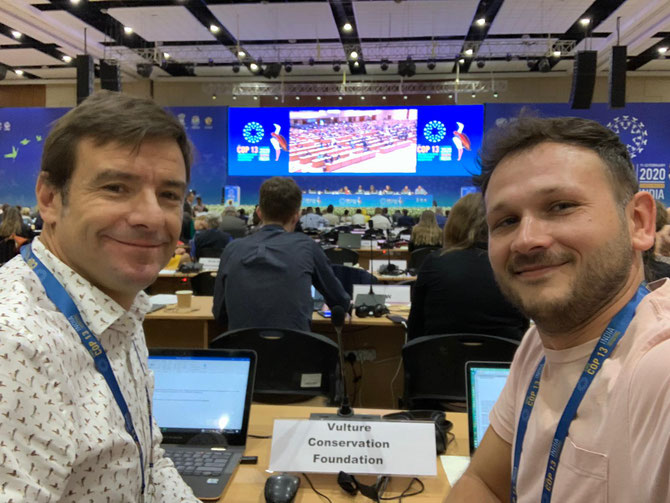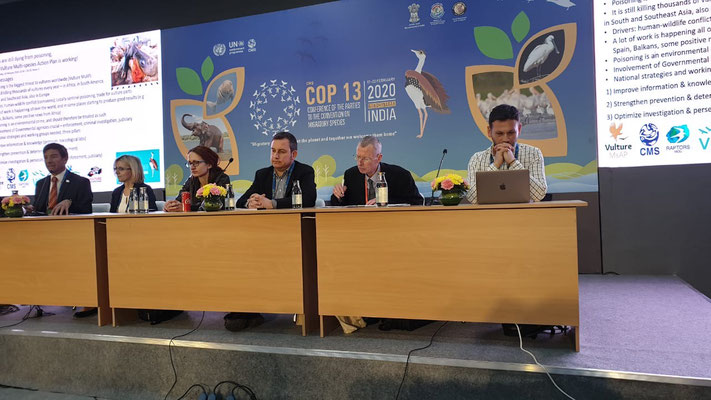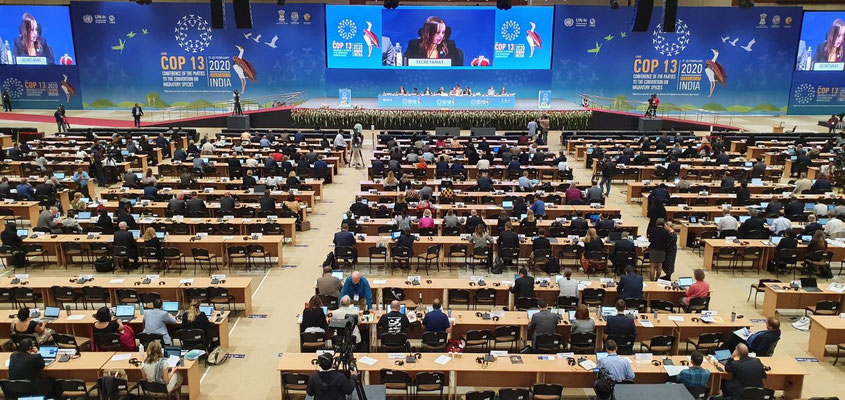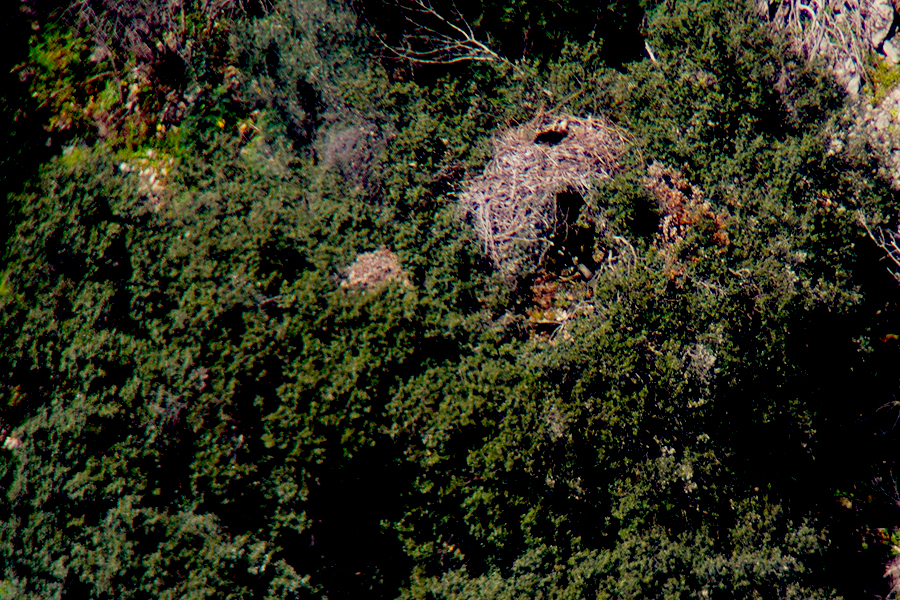
Vultures, vultures, vultures! The 2,500 participants in the biggest ever Conference of the Parties of the CMS (held in Gandhinagar, India, between the 15 and the 22 February) have certainly heard about vultures. Vultures were the focus of at least 4 side events and were talked about by the representatives from 82 governments (signatories to the Convention), 50 representatives from United Nations Agency, 70 other representatives of international NGOs and over 100 members of both national and international media.
The VCF and Vulture MsAP at CMS COP13
The Vulture Conservation Foundation (VCF) was invited to take part in the CoP13 as one of the key players in the development, coordination and implementation of the Vulture Multi-species Action Plan, the global blueprint for Old World vulture conservation, that had precisely been endorsed by the CMS at the previous CoP (in October 2017). Two and a half years into the process, we helped launch the implementation plan for this document, that assesses progress so far, and kept engaging with all the stakeholders to keep vultures high in the agenda.
Key vulture related messages from the side events and the floor
- The Vulture MsAP is being successfully implemented and is producing good results – vultures in Europe are increasing and improving their status, and in Africa and Asia, where actions have been implemented, we are starting to see some positive outcomes.
- Poison is the biggest threat to vultures and scavengers worldwide – usually driven by human-wildlife conflict associated with hunting or livestock breeders. In Africa, there is also the sentinel poisoning (where poachers kill vultures to prevent them from working as sentinels for enforcement agencies) and some direct poisoning of vultures for belief-based uses.
- Poisoning of vultures and other wildlife is an environmental crime and should be treated as such – thus engagement of the governmental authorities is a must.
- In Europe and elsewhere, where authorities are engaging, you can make good progress in terms of identification, forensic investigation, and even prosecution of these crimes.
- Illegal poisoning does not affect only vultures – as it was evident in the CoP, cranes, bustards, Anatidae, etc. are often poisoned, purposely or accidentally, often using the same substances. Horizontal working with these groups and also with carnivore conservation stakeholders is a must. Experience in the reduction of mortality of vultures in Europe following ingestion of poison baits used to kill predators was recognised as a valuable model for application to migratory birds in Asia. Overall, the next steps highlighted were what the VCF uses and promotes in all our projects: monitoring and research to identify high risk areas, document mortality and establish a shared database; identify commonly-used poisons; collaborate with toxicologists; work with decision makers on policy and enforcement; train first responders to collect and handle samples, volunteers to rescue birds, local enforcement officers to identify species, and laboratories to test samples; assess motivations and socio-economic aspects of poisoning; and highlight human health aspects to government agencies and other stakeholders.
- In South Asia, the veterinary drug diclofenac, that has wiped out populations there, continues to be a threat, and the CMS has urged parties to conduct safety testing of existing veterinary NSAID molecules and withdraw licensing of vulture-toxic NSAIDs (including diclofenac) for veterinary use or implement adequate risk assessment with particular reference to known threats to vultures and Aquila eagles, as well as to ensure safety testing of new veterinary NSAIDs on these groups of birds as part of protocol before they are licensed, and to contribute to identification and promotion of safe alternative drugs.
- A new task force on lead poisoning – highly relevant for the vultures and the VCF work, has been created, and will hopefully help progress and push forward the gradual elimination of lead from hunting ammunition. This will certainly also contribute to the ongoing reviews in Europe lead by the European Union – the VCF has also just submitted a LIFE proposal to work on this matter across the Alps, focussed on the Bearded Vulture.
Government involvement is essential to protect vultures
One of the most relevant results of the CoP was to see that several governments – particularly from Europe, recognised the importance of engagement in the fight against poison. The best practice and examples of Spain, where some of the best programmes, strategies and action on the fight against illegal poison are, were discussed, including ongoing and potential intergovernmental exchanges on this area, and several Balkan countries also emphasised the progress on this front by their own agencies, often working together with NGOs. The European Union – which was also represented in the side event organised by the VCF, picked up on several of the messages and introduced wording and/or a few new paragraphs to the poisoning and illegal killing resolutions, as discussed later in the day in the avian working group – on the need for further governmental involvement on the fight against poison baits and on enforcement!
Ecological connectivity and vultures
Overall, the CoP was a great forum to address and push global conservation issues. The floor sent a strong message on the importance of the concept of ecological connectivity for the new global biodiversity strategy that is now being prepared for the Post 2020 Global Biodiversity Framework. This is also very relevant for vultures, who forage or migrate over vast spaces and depend on many areas for their survival. Indeed, the VCF has been at the forefront of pushing this connectivity issue within vulture conservation, first and foremost trying to connect populations under a metapopulation approach (Bearded Vultures in Europe, GYPCONNECT LIFE project), then by highlighting ecological connectivity issues through all the tracking work we do on vultures (movement and space use analysis), and also institutional connectivity that builds on effective cooperation and governance – the VCF is at the forefront of many such efforts, promoting and facilitating international institutional connectivity for vulture conservation.
Other highlights from the conference

There was the usual suite of species added to the Annexes of the convention, thus securing enhanced protection – ten in total, including the Asian Elephant, Jaguar and the Great Indian Bustard – even though the cheering after each species was approved for addition to the annex was misplaced – seemed that the crowd was applauding the eminent extinction!
There was also some significant progress in the development of the Central Asian Flyway, which is also relevant for vultures some Eurasian species (Cinereous, Egyptian, Griffon and Himalayan Griffon Vultures) also use this flyway, which is now going to have a secretariat based in India .
Overall, the Cop concluded that despite some success stories, the populations of most migratory species covered by CMS are declining, following a comprehensive assessment. This is no surprise for conservationists but should result in a real wake-up call for the wider society – we are entering a massive extinction crisis.
Vulture wise, the CoP further progresses on some technical aspects and calls to integrate vulture and other species needs into national energy and climate policy and promote wildlife-friendly renewable energy, and to strengthen initiatives to combat the illegal killing of vultures, including poison.
All in all, good outcomes – and vultures were certainly part of the script. As we often say – all together for Vultures!
Sign up to our newsletter and never miss any vulture news!














